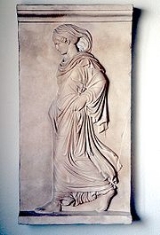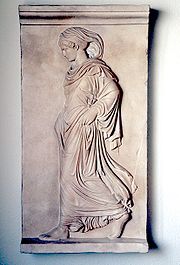
Gradiva
Encyclopedia

Neo-Attic
Neo-Attic or Atticizing is a sculptural style, beginning in Hellenistic sculpture and vase-painting of the 2nd century BCE and climaxing in Roman art of the 2nd century CE, copying, adapting or closely following the style shown in reliefs and statues of the Classical and Archaic periods...
Roman bas-relief in the manner of Greek works of the fourth century BCE, depicting a young robed woman who lifts the hems of her skirts to stride forward. The relief is in the Vatican Museums
Vatican Museums
The Vatican Museums , in Viale Vaticano in Rome, inside the Vatican City, are among the greatest museums in the world, since they display works from the immense collection built up by the Roman Catholic Church throughout the centuries, including some of the most renowned classical sculptures and...
. This sculpture was the basis for the 1903 novel Gradiva
Gradiva (novel)
Gradiva is a novel by Wilhelm Jensen, first published in Germany in 1903. It was inspired by a Roman bas-relief of the same name and became the basis for Sigmund Freud's famous 1907 study Delusion and Dream in Jensen's Gradiva...
by German
Germany
Germany , officially the Federal Republic of Germany , is a federal parliamentary republic in Europe. The country consists of 16 states while the capital and largest city is Berlin. Germany covers an area of 357,021 km2 and has a largely temperate seasonal climate...
writer Wilhelm Jensen
Wilhelm Jensen
Wilhelm Hermann Jensen was a German writer and poet.-Biography:Wilhelm Jensen was born at Heiligenhafen in Holstein , the natural son of Swenn Hans Jensen , the Mayor of the city of Kiel, later administrator of the German/Danish island of Sylt, who came of old patrician Frisian stock...
.
Sigmund Freud
Sigmund Freud
Sigmund Freud , born Sigismund Schlomo Freud , was an Austrian neurologist who founded the discipline of psychoanalysis...
famously analysed the novel, particularly Hanold's dreams, in his 1907 study (Der Wahn und die Träume in W. Jensens 'Gradiva, 1907, or in translation: Delusion and Dream in W. Jensen's 'Gradiva'
Delusion and Dream in Jensen's Gradiva
Delusion and Dream in Jensen's Gradiva is an essay by Sigmund Freud that subjects the novel Gradiva by Wilhelm Jensen, and especially its protagonist, to psychoanalysis....
), a unique example of his psychoanalysing a fictional character. Freud interpreted Hanold's fetish as being a substitution for unresolved feelings for his childhood playmate, Zoe Bertgang.
Freud owned a copy of this relief, which he joyfully beheld in the Vatican Museums in 1907; it can be found on the wall of his study (the room where he died) in 20 Maresfield Gardens, London—now the Freud Museum
Freud Museum
The Freud Museum, at 20 Maresfield Gardens in Hampstead, was the home of Sigmund Freud and his family when they escaped Nazi annexation of Austria in 1938. It remained the family home until Anna Freud, the youngest daughter, died in 1982. The centrepiece of the museum is Freud's study, preserved...
.
Salvador Dalí
Salvador Dalí
Salvador Domènec Felip Jacint Dalí i Domènech, Marquis de Púbol , commonly known as Salvador Dalí , was a prominent Spanish Catalan surrealist painter born in Figueres,Spain....
used the name "Gradiva" as a nickname for his wife, Gala Dalí
Gala Dalí
Gala Dalí , usually known simply as Gala, was the wife of first Paul Éluard, then Salvador Dalí, and an inspiration for them and many other writers and artists.- Early years :...
. He used the figure of Gradiva in a number of his paintings, including Gradiva encuentra las ruinas de Antropomorphos (Gradiva finds the ruins of Antropomorphos). The figure Gradiva was used in other Surrealist paintings
Surrealism
Surrealism is a cultural movement that began in the early 1920s, and is best known for the visual artworks and writings of the group members....
as well. Gradiva (Metamorphosis of Gradiva), 1939, by Andre Masson, explores the sexual iconography of the character. Gradiva, 'the woman who walks through walls' is the muse
Muse
The Muses in Greek mythology, poetry, and literature, are the goddesses who inspire the creation of literature and the arts. They were considered the source of the knowledge, related orally for centuries in the ancient culture, that was contained in poetic lyrics and myths...
of Surrealism.
In 1937 the Surrealist writer André Breton
André Breton
André Breton was a French writer and poet. He is known best as the founder of Surrealism. His writings include the first Surrealist Manifesto of 1924, in which he defined surrealism as "pure psychic automatism"....
opened an art gallery on the Left Bank, 31 rue de Seine, christening it with the title: Gradiva. Marcel Duchamp
Marcel Duchamp
Marcel Duchamp was a French artist whose work is most often associated with the Dadaist and Surrealist movements. Considered by some to be one of the most important artists of the 20th century, Duchamp's output influenced the development of post-World War I Western art...
designed it, giving its door the form of a double cast shadow.

